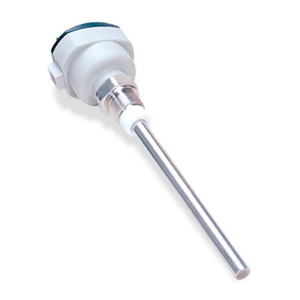LV3000 and LV4000 Series
Capacitance Continuous Level Measurement Probes and Switch
Description
Click on this link if you need more information about Level sensor.
The LV3000/LV4000 Series
Continuous Level Measurement
probes are the most flexible, as well
as cost effective, level solutions for
a great variety of applications.
The built-in (one-piece) electronic
module provides a 4 to 20 mA
output (2 wire) signal that is
proportional to the process level.
The LV3000/LV4000 Series
features a potentiometer to account
for varying sensitivity according to
the medium or product, tank
dimensions, rod length,
position of installation as well
as other application features.
Rods can be coated with
PTFE as an option.
The wide range of applications for
RF analogue level measurement
probes (such as liquids and
pastes), requires attention in
selecting the correct level probe
and installing it in the proper
location. The probe is the primary
measuring element and must be
capable of producing enough
capacitance variance as it becomes
submerged in the measured
product. To cater to all applications,
OMEGA’s capacitance probes are
offered with different designs and
features. The success of how the
probes are applied depends on
these important factors:
A) Materials that are conductive
can cause a short circuit between a
bare stainless steel probe and the
tank wall. As the liquid level drops,
the probe remains wetted, providing
a conductive path between the
probe and the tank wall. The faster
the level changes, the more likely
this false indication is to occur. For
this situation, we recommend the
use of PTFE or other types of
insulator coatings on the rod
surface.
B) Material build-up also affects the
accuracy of RF capacitive
measurements, and therefore
additional adjustment to the probe’s
sensitivity is recommended.
Housings must also be compatible
with the requirements for
hazardous, wash-down, wet, and/or
dusty environments. Explosion proof
environments may require the
housing to be certified. In addition,
the active probe might need to be
intrinsically safe or have an intrinsic
safety barrier.
The electronic circuitry of the probe
performs several functions such as
rectifying and filtering the incoming
power, generating the radio
frequency signal, measuring the
changes in current flow, analogue
signal generators and display
meters. The circuitry is provided
with potentiometer adjustments for
setting sensitivity that is located in
the housing of the probe. These
adjustments give an added level of
fine tuning which enable our
customers to control the probes’
sensitivity with greater accuracy.
The LVCN4300 Series point level
switch probe works as a remote
probe and is compatible with the
LVCN400 series relay. This
combination allows the electrode to
be used in temperatures up to
177°C (350°F). The LVCN4300 is a
very compact 316SS switch.
† All amounts shown in EUR, GBP, or USD
Note: Comes complete with operator’s manual.
LV4000 Series length is not recommended below 24" due to dielectric strength.
 CLOSE
CLOSE



